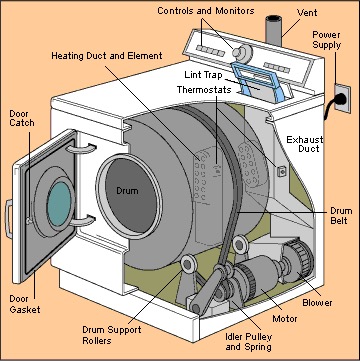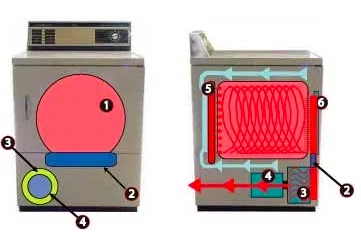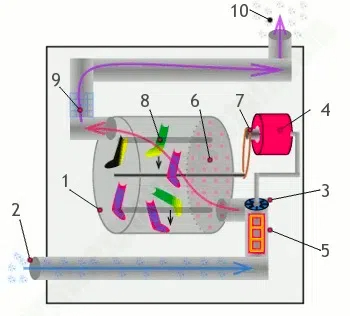
Content Menu
● Introduction
● Basic Components and Operation
● The Drying Process
● Types of Dryers
● Advanced Features and Technology
● Maintenance and Care
● Energy Efficiency Considerations
● Troubleshooting Common Issues
● Safety Considerations
● Environmental Impact
● Frequently Asked Questions
>> Q1: How long should a dryer last?
>> Q2: Which is more efficient, gas or electric dryers?
>> Q3: How often should I clean the lint filter?
>> Q4: Why is my dryer taking too long to dry clothes?
>> Q5: Are heat pump dryers worth the investment?
Introduction
Modern clothes dryers have become an essential appliance in homes worldwide, making laundry tasks more convenient and efficient. Understanding how these machines work can help you use them more effectively and maintain them properly.
Basic Components and Operation
A clothes dryer consists of several key components that work together to remove moisture from wet clothes:
1. Drum
2. Heating Element
3. Motor
4. Blower/Fan
5. Thermostat
6. Control Panel
7. Venting System
8. Lint Filter
The Drying Process
The drying process involves a sophisticated combination of heat, airflow, and mechanical action:
1. Air Intake
2. Heating Phase
3. Tumbling Action
4. Moisture Removal
5. Air Exhaust

Types of Dryers
There are several types of clothes dryers available in the market:
1. Electric Dryers
- Most common type
- Uses electric heating elements
- Requires 240V outlet
- Generally more affordable
2. Gas Dryers
- Uses natural gas or propane
- More energy-efficient
- Faster drying times
- Requires gas line installation
3. Heat Pump Dryers
- Most energy-efficient
- Uses heat pump technology
- Gentler on clothes
- Higher initial cost
4. Condenser Dryers
- No external venting required
- Collects moisture in a container
- Popular in apartments
- Less energy-efficient
Advanced Features and Technology
Modern dryers come equipped with various advanced features:
1. Moisture Sensors
- Automatically detect clothing dampness
- Adjust drying time accordingly
- Prevent over-drying
- Save energy
2. Smart Technology
- WiFi connectivity
- Remote monitoring
- Custom cycle programming
- Maintenance alerts
3. Steam Features
- Wrinkle removal
- Sanitization
- Odor elimination
- Fabric refreshing
Maintenance and Care
Regular maintenance is crucial for optimal dryer performance:
1. Clean the lint filter before each use
2. Inspect and clean venting system annually
3. Check and clean moisture sensors
4. Verify proper airflow
5. Monitor unusual sounds or vibrations

Energy Efficiency Considerations
To maximize energy efficiency:
1. Sort loads properly
2. Clean lint filter regularly
3. Use appropriate heat settings
4. Avoid overloading
5. Maintain proper ventilation
Troubleshooting Common Issues
Common problems and solutions:
1. Not Heating
- Check power supply
- Verify thermostat function
- Inspect heating element
- Clean venting system
2. Long Drying Times
- Clean lint filter
- Check for vent blockages
- Avoid overloading
- Verify proper cycle selection
3. Excessive Noise
- Check drum support
- Inspect belt condition
- Verify motor operation
- Tighten loose components
Safety Considerations
Important safety measures:
1. Proper Installation
2. Regular Maintenance
3. Appropriate Use
4. Fire Prevention
5. Child Safety
Environmental Impact
Consider environmental factors:
1. Energy Consumption
2. Water Usage (for steam features)
3. Carbon Footprint
4. Sustainable Options
5. Recycling Considerations

Frequently Asked Questions
Q1: How long should a dryer last?
A: With proper maintenance, a quality dryer can last 10-15 years. Regular cleaning and maintenance can extend its lifespan significantly.
Q2: Which is more efficient, gas or electric dryers?
A: Gas dryers are generally more energy-efficient and cost-effective to operate, although they have a higher initial cost and require proper gas line installation.
Q3: How often should I clean the lint filter?
A: The lint filter should be cleaned before every drying cycle to maintain efficiency and prevent fire hazards.
Q4: Why is my dryer taking too long to dry clothes?
A: Long drying times can be caused by lint buildup, blocked venting, overloading, or malfunctioning heating elements. Regular maintenance can prevent most of these issues.
Q5: Are heat pump dryers worth the investment?
A: Heat pump dryers are more expensive initially but can save significant energy costs over time. They're particularly worthwhile in areas with high electricity rates or for frequent users.












